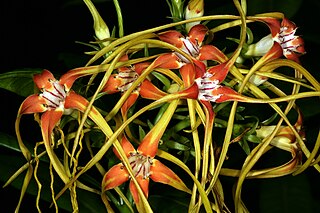
Strophanthus is a genus of flowering plants in the family Apocynaceae, first described as a genus in 1802. It is native primarily to tropical Africa, extending to South Africa, with a few species in Asia from southern India to New Guinea and southern China. The genus name is a compound of the Greek words στροφος (strophos) "twisted" and ανθοσ (anthos) "flower", in reference to the corolla lobes which, in some species - notably S. petersianus - resemble long twisted ribbons or threads and can reach a length of 30–35 cm. This trait, in addition to colouring involving combinations of bright pinks, purples and oranges, combine to make the flowers among the most ornamental in the plant kingdom.
Erythrococca is a plant genus of the family Euphorbiaceae, first described in 1849. It is native to Africa and the Arabian Peninsula.

Drypetes is a plant genus of the family Putranjivaceae, in the order Malpighiales.
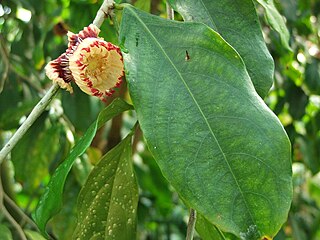
Napoleonaea is a genus of woody plant in the family Lecythidaceae first described as a genus in 1804, the same year its namesake crowned himself Emperor of the French. The genus is native to Africa.
Thomandersia is the sole genus in the Thomandersiaceae, an African family of flowering plants. Thomandersia is a genus of shrubs and small trees, with six species native to Central and West Africa.
Hunteria is a genus of plants in the family Apocynaceae first described as a genus in 1824. It is native to Africa and to South and Southeast Asia.
- Hunteria ballayiHua - Central African Republic, Republic of Congo, Cameroon, Gabon
- Hunteria camerunensisK.Schum. ex Hallier f. - Republic of Congo, Cameroon, Gabon
- Hunteria congolanaPichon - Republic of Congo, Zaïre, Kenya
- Hunteria densifloraPichon - Zaïre
- Hunteria ghanensisJ.B.Hall & Leeuwenb. - Ivory Coast, Ghana
- Hunteria hexaloba(Pichon) Omino - Gabon
- Hunteria macrosiphonOmino - Republic of Congo, Gabon
- Hunteria myrianthaOmino - Zaïre
- Hunteria oxyanthaOmino - Republic of Congo, Zaïre, Gabon
- Hunteria simii(Stapf) H.Huber - Guinea, Ivory Coast, Liberia, Sierra Leone
- Hunteria umbellata(K.Schum) Hallier f. - W + C Africa from Senegal to Zaïre
- Hunteria zeylanica(Retz.) Gardner ex Thwaites - Somalia, Kenya, Tanzania, Mozambique, S China, India, Sri Lanka, Andaman & Nicobar Islands, Indochina, W Malaysia, Sumatra
Magnistipula is a genus of plant in family Chrysobalanaceae described as a genus in 1905.

Palisota is a genus of plant in family Commelinaceae, first described in 1828. It is native to sub-Saharan Africa.
Pausinystalia is a largely African genus of plant in the family Rubiaceae. As of the present time Pausinystalia contains the following 5 species:
Turraeanthus africana is a species of plant in the family Meliaceae, also known by the common names avodiré, apeya, engan, agbe, lusamba, wansenwa, African satinwood, and African white mahogany.
Eremospatha is a genus of climbing flowering plants in the palm family found in tropical Africa. These rattans are uncommon in cultivation and poorly understood by taxonomists;. Closely related to Laccosperma, they differentiated by the near complete absence of bracts and bracteoles. The name is from Greek meaning "without a spathe".
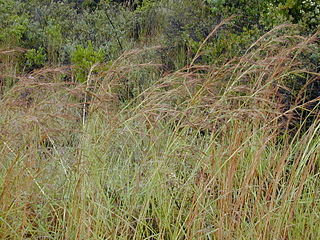
Hyparrhenia is a genus of grasses. Many species are known commonly as thatching grass.

Cercestis is a genus of flowering plants in the family Araceae. The species in this genus are all climbers and are endemic to Africa. At intervals along the stem they produce long leafless shoots called flagella. Many of the species in Cersestis show signs of fenestration.
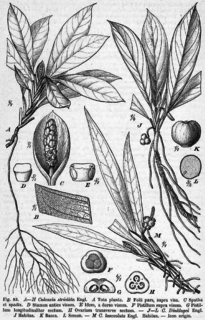
Culcasia is a genus of flowering plants in the family Araceae, native to tropical Africa. Most of its species are climbers and resemble Cercestis except for the fact that they don't produce flagella.
- Culcasia angolensisWelw. ex Schott - western + central Africa from Senegal to Angola
- Culcasia annetiiNtépé-Nyamè - Ivory Coast, Cameroon, Liberia
- Culcasia bosiiNtépé-Nyamè - Cameroon, Gabon, Congo-Brazzaville
- Culcasia brevipetiolataBogner - Gabon
- Culcasia caudataEngl. - Zaïre
- Culcasia dinklageiEngl - western + central Africa from Liberia to Zaïre
- Culcasia ekongoloiNtépé-Nyamè - central Africa from Nigeria to Zaïre
- Culcasia falcifoliaEngl. - central Africa from Gabon east to Tanzania and south to Mozambique
- Culcasia glandulosaHepper - Ivory Coast, Sierra Leone, Liberia, Congo-Brazzaville
- Culcasia insulanaN.E.Br. - Zaïre, Cameroon, Gulf of Guinea Islands
- Culcasia lanceolataEngl. - Cameroon, Gabon
- Culcasia libericaN.E.Br. - Ivory Coast, Sierra Leone, Liberia, Togo
- Culcasia linearifoliaBogner - Cameroon, Gabon
- Culcasia loukandensisPellegr - Cameroon, Gabon, Congo-Brazzaville, Zaïre, Central African Republic
- Culcasia mannii(Hook.f.) Engl. - Cameroon, Gabon, Congo-Brazzaville, Nigeria, Equatorial Guinea
- Culcasia obliquifoliaEngl. - Cameroon, Gabon
- Culcasia orientalisMayo - Kenya, Tanzania, Mozambique, Zambia
- Culcasia panduriformisEngl. & K.Krause - Cameroon, Gabon
- Culcasia parvifloraN.E.Br. - western + central Africa from Liberia to Zaïre
- Culcasia rotundifoliaBogner - Gabon
- Culcasia sanagensisNtépé-Nyamè - Cameroon
- Culcasia scandensP.Beauv. - western + central Africa from Liberia to Angola
- Culcasia seretiiDe Wild - western + central Africa from Liberia to Zaïre
- Culcasia simiarumNtépé-Nyamè - western Africa from Ivory Coast to Cameroon
- Culcasia striolataEngl. - western + central Africa from Liberia to Congo-Brazzaville
- Culcasia tenuifoliaEngl. - western + central Africa from Liberia to Zaïre
- Culcasia yangambiensisLouis & Mullend. - Congo-Brazzaville, Zaïre
Guaduella is a genus of African plants in the grass family, the only genus in the tribe Guaduelleae. It belongs to the subfamily Puelioideae, one of the early-diverging lineages in the grasses, but used to be included in the bamboos.
- Guaduella densifloraPilg. - Nigeria, Cabinda, Cameroon, Republic of Congo, Gabon, Equatorial Guinea
- Guaduella dichroaCope - Cabinda
- Guaduella humilisClayton - Nigeria, Cameroon
- Guaduella macrostachys(K.Schum.) Pilg. - Ghana, Nigeria, Cameroon, Gabon
- Guaduella marantifoliaFranch. - Cameroon, Republic of Congo, Gabon
- Guaduella oblongaHutch. ex Clayton - Guinea, Sierra Leone, Ivory Coast, Cameroon, Republic of Congo, Gabon, São Tomé, Bioko

Ancistrorhynchus is a genus of flowering plants from the orchid family Orchidaceae. It contains 16 species native to tropical Africa.
Cuviera is a genus of flowering plants in the family Rubiaceae native to tropical Africa. It was originally described by Augustin Pyramus de Candolle in 1807 and is named after the French naturalist Georges Cuvier.
Craterispermum is a genus of flowering plants in the family Rubiaceae. It contains 16 species that occur in tropical Africa and Seychelles. It is the only genus in the tribe Craterispermeae, of which the divergence time is estimated at 34.8 million years ago.
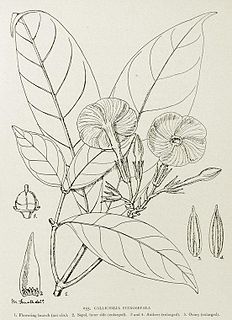
Callichilia is a genus of plant in the family Apocynaceae, native to tropical Africa.
Hypselodelphys is a group of plants in the Marantaceae described as a genus in 1950. native to tropical Africa from Liberia to Uganda and south to Angola. It contains 8 recognized species:








